The Desperate Need for Measurable Foresight
By:
EVP & Group Director, Anthropology
Read the Full Article
Let’s face it, the modern foresight practice is a bit of a mess. But more on that later.
Almost every major corporation is investing in foresight these days, which is of course a development that truly deserves celebration. If we rewind the clock just five years, we’d find that Foresight was barely talked about except when something bad happened to a business. It was certainly not seen as a must-have or as a regular part of the insights and innovation practice. So it is truly commendable that quite a lot has changed for the better in the last few years. These days, it isn’t uncommon to see companies hire a foresight lead, and commit to at least some resources in the form of people and technology in the hopes of creating a repeatable and measurable framework for foresight. The problem is, rarely is that actually implemented.

Thank you!
The Desperate Need for Measurable Foresight
By:
EVP & Group Director, Anthropology
Read the Full Article
Let’s face it, the modern foresight practice is a bit of a mess. But more on that later.
Almost every major corporation is investing in foresight these days, which is of course a development that truly deserves celebration. If we rewind the clock just five years, we’d find that Foresight was barely talked about except when something bad happened to a business. It was certainly not seen as a must-have or as a regular part of the insights and innovation practice. So it is truly commendable that quite a lot has changed for the better in the last few years. These days, it isn’t uncommon to see companies hire a foresight lead, and commit to at least some resources in the form of people and technology in the hopes of creating a repeatable and measurable framework for foresight. The problem is, rarely is that actually implemented.
I’ve spoken to many foresight practice leaders in the past 6 months across all types of industries including many B2B businesses. I’ve discovered that while there’s a fair bit of resources being committed, most foresight outcomes still sit as static deliverables (usually in PowerPoint decks) and result from a combination of secondary sources (syndicated reports and publications). Some more sophisticated approaches include primary analysis of consumer data usually done in conjunction with a foresight thought leader who facilitates brainstorms and owns the creation of a unified framework. All is well and good until someone asks the dreaded question, “so how do we operationalize this?”
The biggest problem with foresight projects is simply just that. They’re seen as projects that run in specific periods of time resulting in static outcomes and often outcomes that are largely disconnected from the everyday reality of a business.
Foresight does not always mean having to deal with big and hairy questions about our society and the future of humankind. Foresight CAN and in fact MUST begin with answering practical questions about how the culture surrounding a product or technology is evolving. It must ask what new cultures are developing that might offer new adjacent spaces for our products and solutions. And it must ask how the makeup of audiences within these cultures and adjacent spaces is naturally evolving.
When foresight is done right, it should set the company’s insight and innovation agenda. It should not sit in its own ether, making its way into water cooler conversations yet driving little in the way of practical change to a business and its products.
When foresight is done right, it should guide the language and thinking of the C-Suite and should give the organization and its leaders a ‘filter’ with which to evaluate all emerging trends, signals, and opportunities that affect the business.
When foresight is done right, it creates a unified framework and language with which everyone within the organization can understand and empathize with the consumer and the underlying human need at play.
When foresight is done right it isn’t subjective, its outcomes are measurable and predictable. This means foresight is accountable in the same way that insights and R&D might be in an effective organization.
Making Foresight Measurable: The Consumer Hierarchy Model
The foundation of a good foresight program is a model that is grounded in the underlying human reality. This means the first step in building a foresight program is to understand how the human being (consumer) interprets new information in the context of your category or business.
To achieve this, we begin with a consumer hierarchy model. In simple terms, it tells us how the consumer contextually organizes and structures information in their minds.
Let me give you an example.
Here’s a sample hierarchy model in the context of food. The hierarchy shows us how the consumer fields any new information around food, and then organizes it quickly and rapidly in their minds so as to make sense of it.
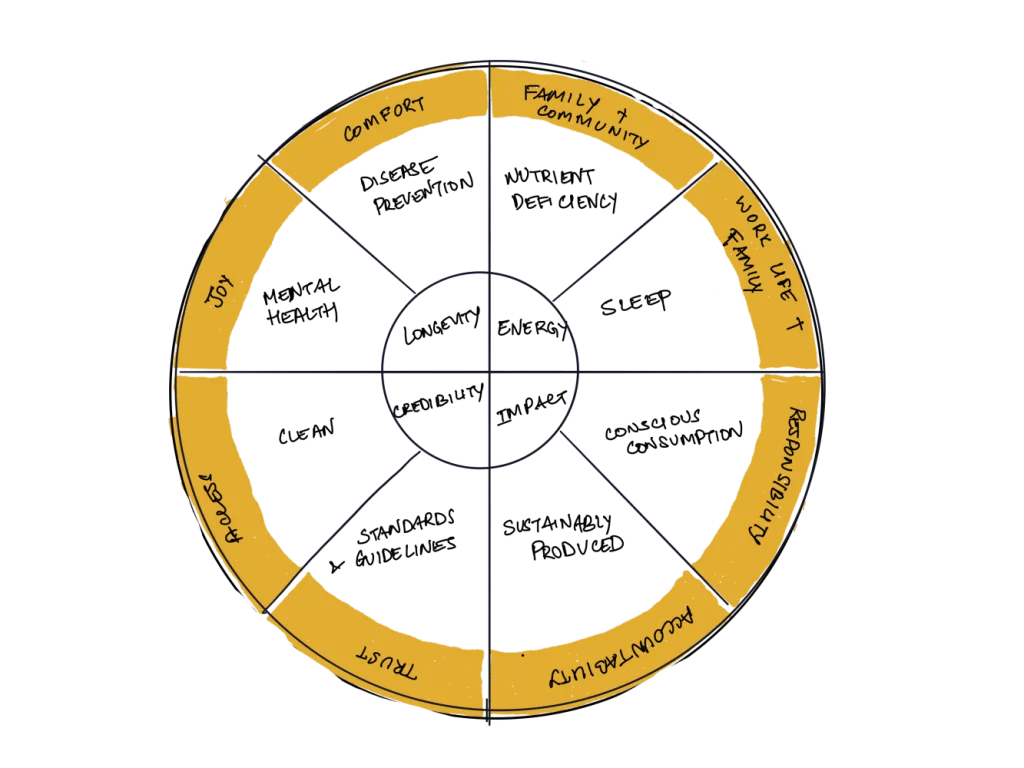
At the center of the model lies the underlying core beliefs that drive the consumer’s mindset around food. In this example, there are four core belief systems that the consumer uses to filter any new information (new products, ideas, concepts, etc.) in their minds.
The second concentric ring decodes the dominant demand drivers within each core belief. So it builds on the underlying belief-based framework to deliver tangible ‘zones’ of engagement and demand for the consumer. To deliver a concrete example here, consider the belief around credibility. As we can see, the consumer looks at credibility only through two lenses – the lens of what they consider ‘clean’ food and the lens of existing and newly defined standards and guidelines. This means any new ideas and products we bring forward as an organization will be evaluated for credibility based on how well it fits into one of these two drivers.
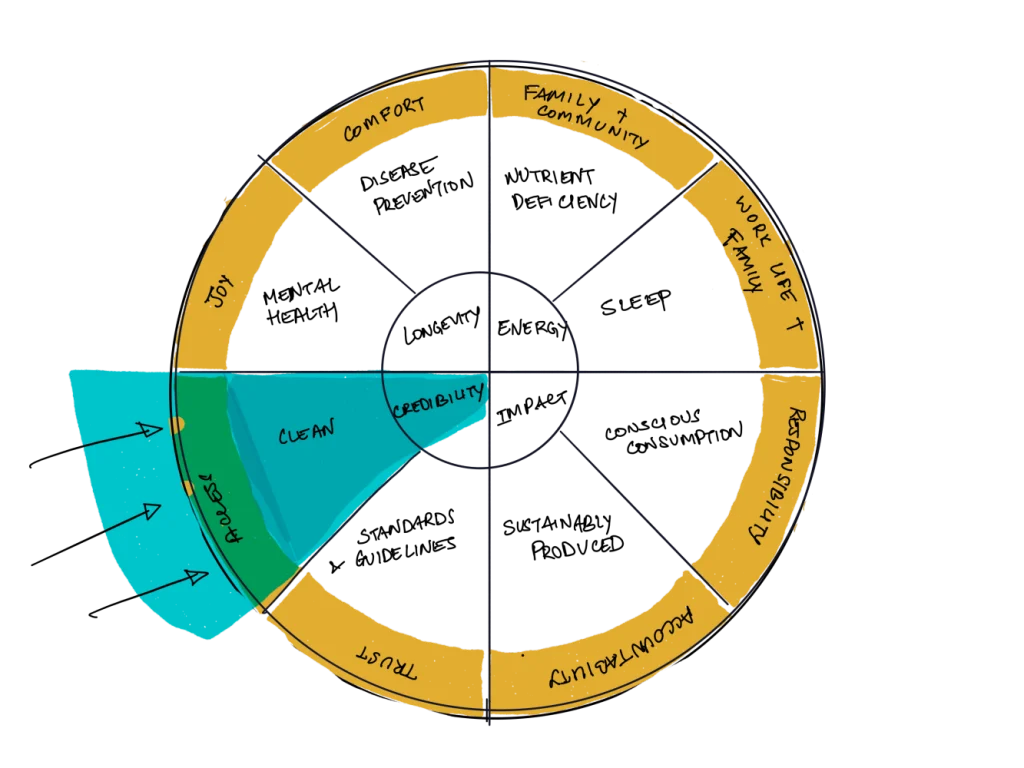
In essence, what you’re seeing here is the consumer’s pathway to credibility in food. So if credibility is a goal or requirement in your business, this would immediately become an area to prioritize. [e.g. the plant-based and alternative proteins space lacks credibility at the moment and has much work to do.]
The third concentric circle in the model denotes the dominant motivational states relating to each demand driver.
The Process of Generating Foresight
The moment we develop a comprehensive understanding of the consumer hierarchy we can begin asking the first set of questions to drive foresight –
Question 1: How will each of these demand drivers and underlying beliefs evolve in the next 2 to 5 years?
Coming back to the credibility example, if we know that clean is a demand driver, then we need to understand how the meaning of clean will evolve and affect consumer perception of credibility in food.
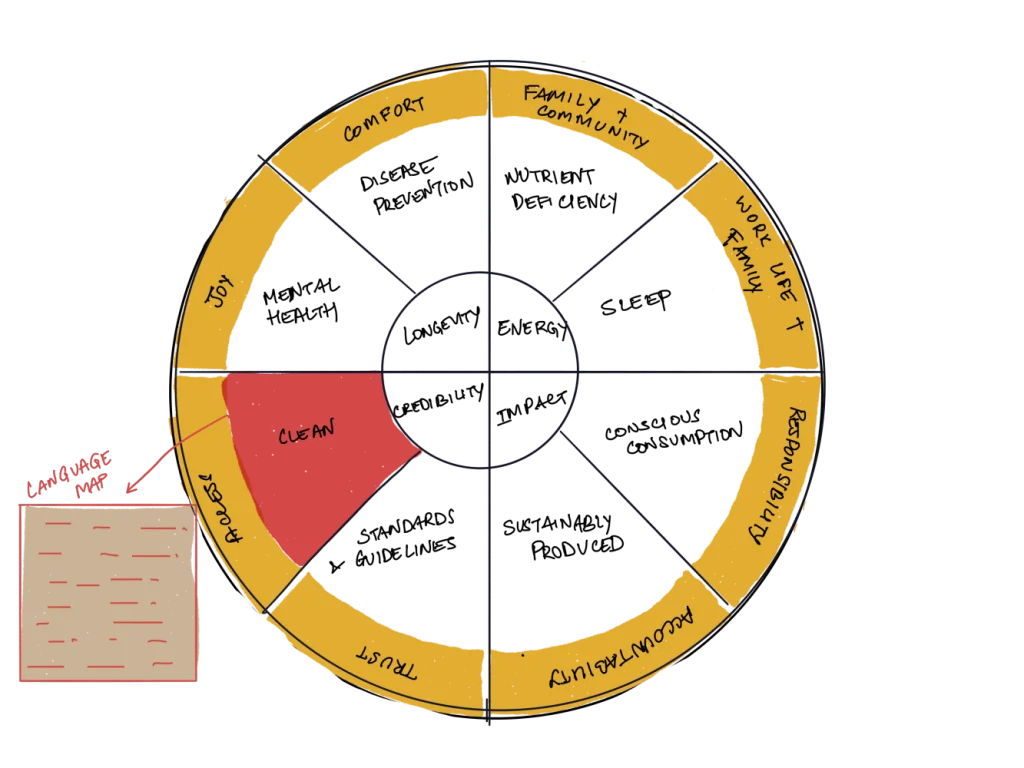
To achieve this, we rely on the power of structural anthropology – i.e. the study of natural patterns of language within the context of a demand driver, at scale. Every demand driver has some critical background data which can be conceived of as a language map that indicates the natural structure of language used by consumers today. This language map functions as a fingerprint that can then be used to begin identifying related emerging signals which tell us about the impending changes in this language map over time. Modeling this out is how we’re able to not just identify the rate of change but also get into the weeds…to the detail of what each demand driver will end up looking like over time.
Question 2: How will the overall hierarchy itself evolve in the next 5 to 10 years?
This is a longer-horizon question because it will tell us what this hierarchical model might look like 5, 7, and 10 years from now.
To achieve this once again we rely on our foundations in structural anthropology. But, instead of looking at the evolution of patterns of language within the context of a demand driver, we do so in the broader context of the industry or space we’re examining. In our example above, this is simply ‘food’ on the whole.
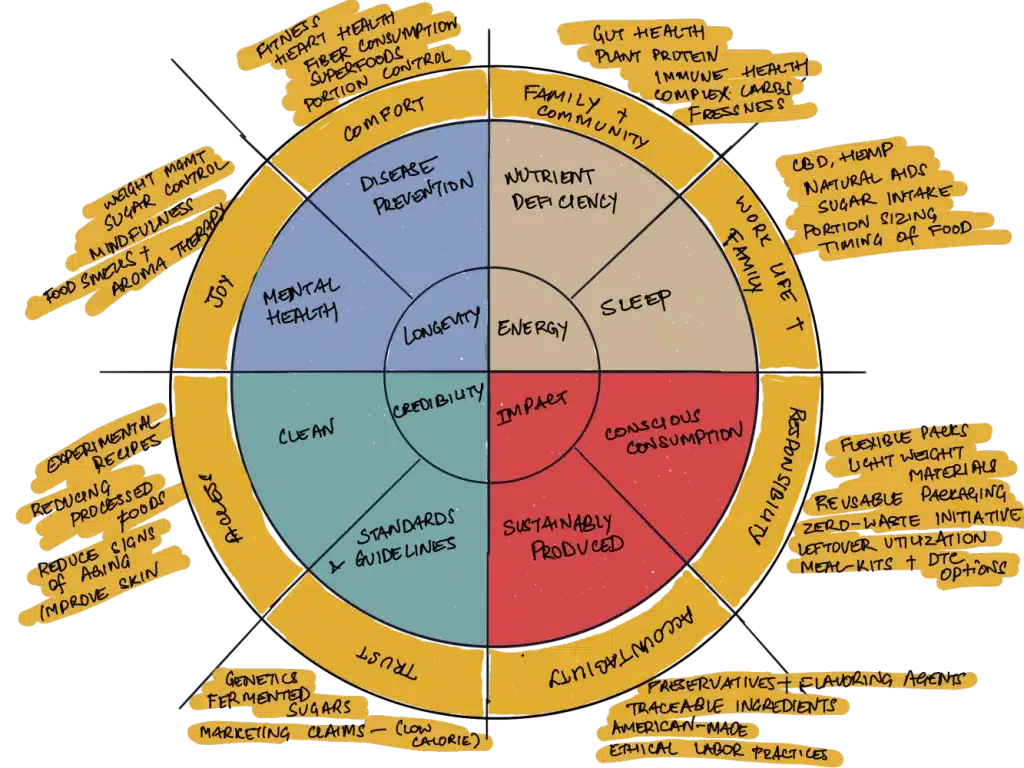
We rely on our ability to extract and examine any and all emerging signals of language use within this broader context of food. Examining these signals and working backward from them allows us to identify how the overall map of language use might be evolving, indicating patterns of model evolution and more specifically allowing us to pinpoint which areas of the model are likely to get disrupted first.
Question 3: Where do sustainability, responsibility, and overall social impact fit into this equation?
Given that these are some of the biggest pressures facing leadership today, it is important to understand how and where they fit into the consumer hierarchy. For example, we might realize that the way the organization thinks of sustainability does not jive with any of the ways in which the consumer expects it to impact their lives. This offers an immediate opportunity to re-align efforts and begin the process of turning the ship around to point in the right direction.
The benefit of the hierarchy is that in addition to helping us proactively identify signals affecting our business, it also allows us to reactively understand specific pressure points that we care about. This is exactly what we’re able to do to provide context into the sustainability and responsibility landscape and bridge the gap between the organization’s interpretation of the space versus that of the consumer’s.
Question 4: Who is my future consumer?
This is perhaps the most challenging question for organizations to grapple with, mainly due to the fact that historically organizations have gone to market with an audience-first, culture-second approach. That is, they decide on which audience they’d like to focus on, and then try to find unified narratives and demand drivers within those cohorts. The challenge with this approach of course is that we force a logical construction and artificial boundary around what an audience is, often defined by generations or demographic parameters. But the fact is that culture does not work in this manner. As a belief system begins to develop the makeup of audiences around it naturally evolves with time.
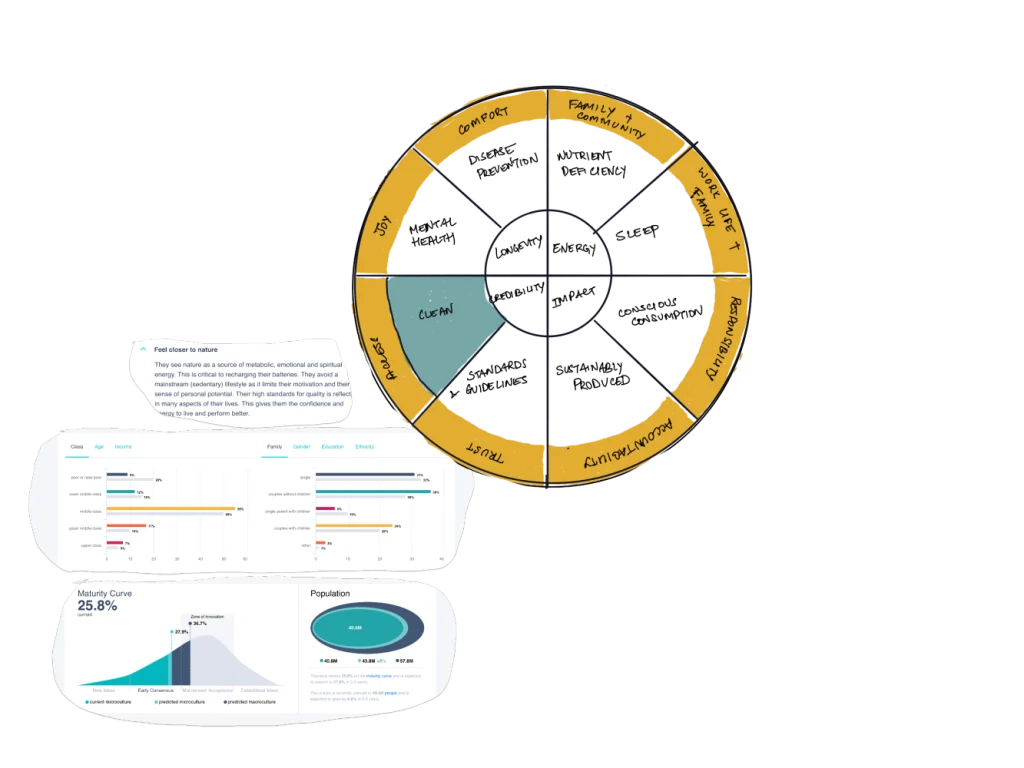
The consumer hierarchy model allows us to realign our understanding of the consumer with how culture actually and naturally evolves. Which further enhances our ability to not just understand the present but better predict the future.
Turning Foresight Into An Accountable Practice
The biggest benefit of the consumer hierarchy model when used in conjunction with anthropology and the mapping of language is that it allows us to bring accountability and operational excellence to the foresight landscape. Every single outcome of the model is a result of tracking and modeling the evolution of patterns of natural language use. Which means every outcome is built with scientific and methodological rigor. As new data enters the model, it makes the model smarter and more fine-tuned with time and improves the organization’s understanding of the future forces that will shape its business.
Are we ready to make foresight a more accountable and measurable practice? I believe so, more so now than ever before as we try to claw our way out of the pandemic, war, inflationary pressure, and whatever else the universe will throw at us. The key is for us to stop trying to make foresight into an academic exercise that somehow predicts the future of the world and instead focus on the most practical, predictable, and measurable aspects of foresight, i.e. the cultural forces that will impact our businesses over the foreseeable future.






